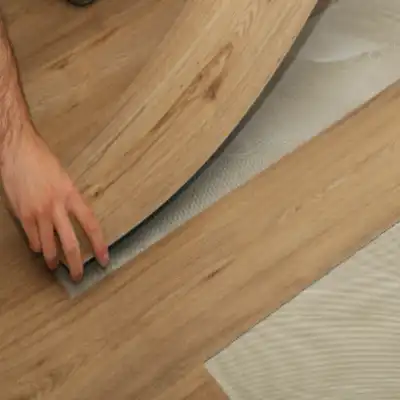Stop worrying about your floors! Instead of adding repairs to your to-do list, add it to ours. Just give us a call, and we will show up to your home on time, with the required tools, and fix any issues you may have with efficient work. We are trustworthy, experienced, and guarantee the job will be done right the first time.
All Mr. Handyman franchises are locally owned and operated and may offer fewer or more services than those listed here. To learn more about laminate flooring services offered in your area, contact your local Mr. Handyman for details or a customized on-site assessment.
Laminate Flooring FAQs
For over 25 years, Mr. Handyman professionals have been helping homeowners repair, maintain, and enhance their space. We are a one-stop solution for everything on your to-do list. This includes answering your questions about home repairs, maintenance, and improvements. Here are answers to some of your most frequently asked questions about laminate flooring services:
What is the downside of installing laminate flooring yourself?
Laminate flooring installation is a big job that requires some tools, experience, and a lot of time. Not all homeowners are up for this type of project, so we always recommend getting support with the installation.
Outside of the hours of preparation, some challenges in installing laminate flooring involve:
- Fitting interlocked boards: Sometimes, interlocking flooring needs to be adjusted for the perfect fit.
- Cutting: Laminate boards are often difficult to cut precisely.
- Shrinking/expanding material: It’s tricky getting laminate flooring acclimated to the climate before installation.
- Measuring custom pieces: Getting pieces cut precisely to fit corners and uniquely shaped rooms can be a nightmare.
- properly interlocking laminate boards.
- Using powerful tools: Not everyone is savvy with flooring tools like miter saws, mallets, or nail guns.
- Installing underlayment: If your laminate flooring does not come with underlayment attached, this separate installation step can take even longer.
Which is better, vinyl or laminate flooring?
The answer depends on your space's needs. Vinyl is a great option if you're looking for something that can handle moisture. It's highly water-resistant, making it perfect for kitchens, bathrooms, or basements. Vinyl is also tough when it comes to durability, standing up well to heavy foot traffic, scratches, and stains.
On the other hand, laminate floors usually offer a more authentic wood look and feel, which makes it a popular choice for living rooms or bedrooms where appearance is key. The downside is that laminate doesn’t hold up as well in areas with moisture. If you want a material that can handle wear and tear, vinyl might be your best bet, but if you're focused on aesthetics and the space is dry, laminate can give you that natural wood vibe.
Do you need underlayment for laminate flooring?
Definitely. Underlayment helps with several things: it adds cushioning for comfort, reduces noise, and adds moisture protection, especially if you're installing it on a concrete subfloor or in a moisture-prone area. Some laminate flooring comes with pre-attached underlayment, but if yours doesn’t, it's usually recommended to install it separately. Just make sure to choose the right underlayment for laminate floor installation.
Where should you not use laminate flooring?
Laminate flooring should not be used in areas prone to high moisture or humidity, such as bathrooms, laundry rooms, or basements with moisture issues. Since laminate is not completely waterproof, exposure to water can cause it to swell, warp, or delaminate over time. Similarly, kitchens can be tricky if there’s a risk of water spills or leaks, though some high-quality laminate is designed to be more water-resistant.
You should also avoid using it in outdoor spaces or areas that experience extreme temperature fluctuations, as this can also affect the integrity of the material. It's best to stick to dry, temperature-controlled areas like living rooms, bedrooms, and hallways for laminate flooring.
Does laminate flooring need underlayment?
Yes. Underlayment is a thin layer of cushioning that provides extra support, reduces noise, and acts as a moisture barrier. It helps your floor last longer and improves comfort underfoot. Even if you're tackling laminate floor repairs on a small section, it’s worth adding or replacing the underlayment for consistent comfort and durability. Proper underlayment helps extend the life of your laminate floor and keeps it feeling solid for years to come.
 Click to call
Click to call


 Click to call
Click to call
